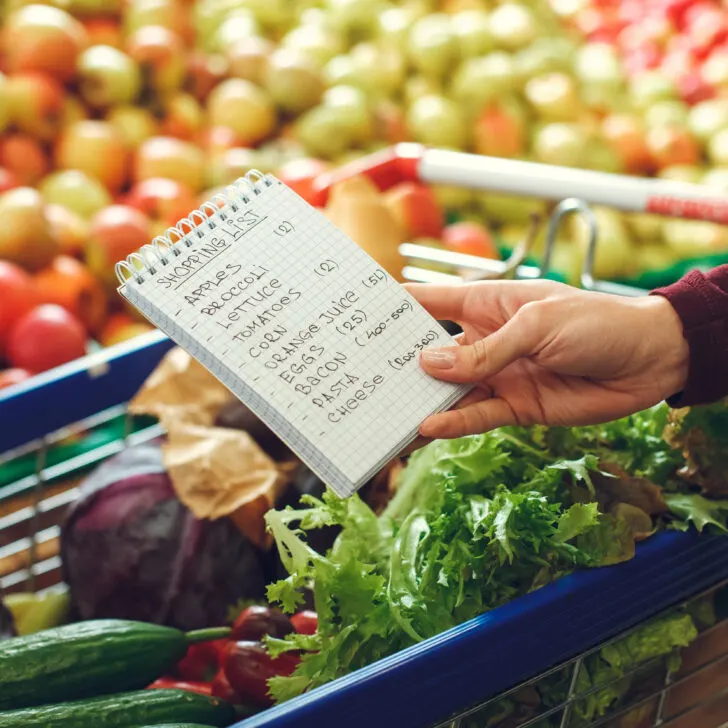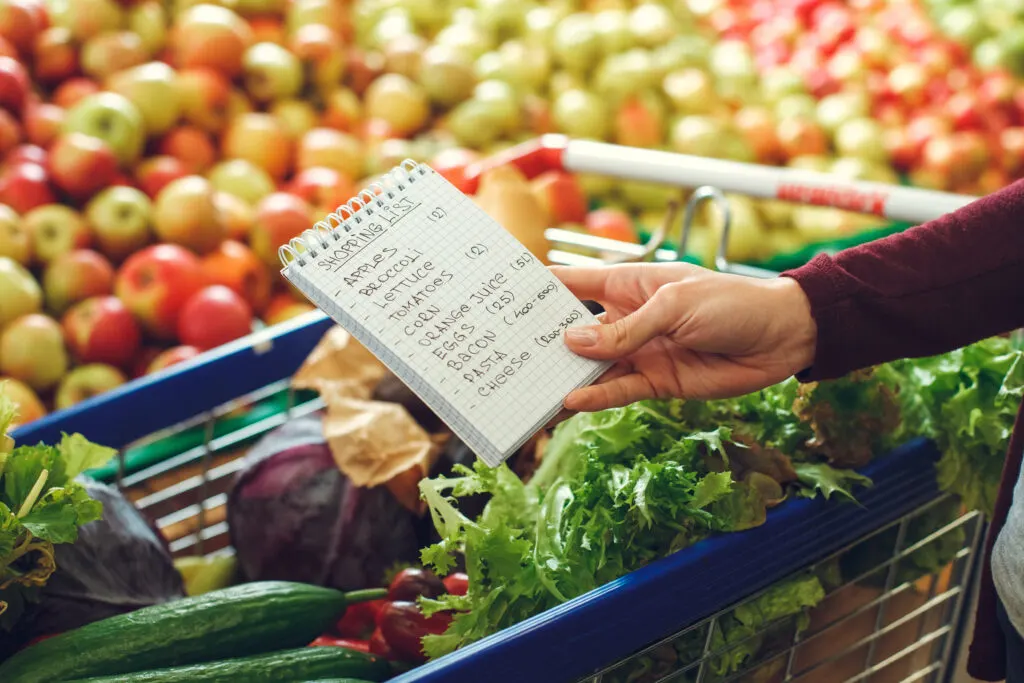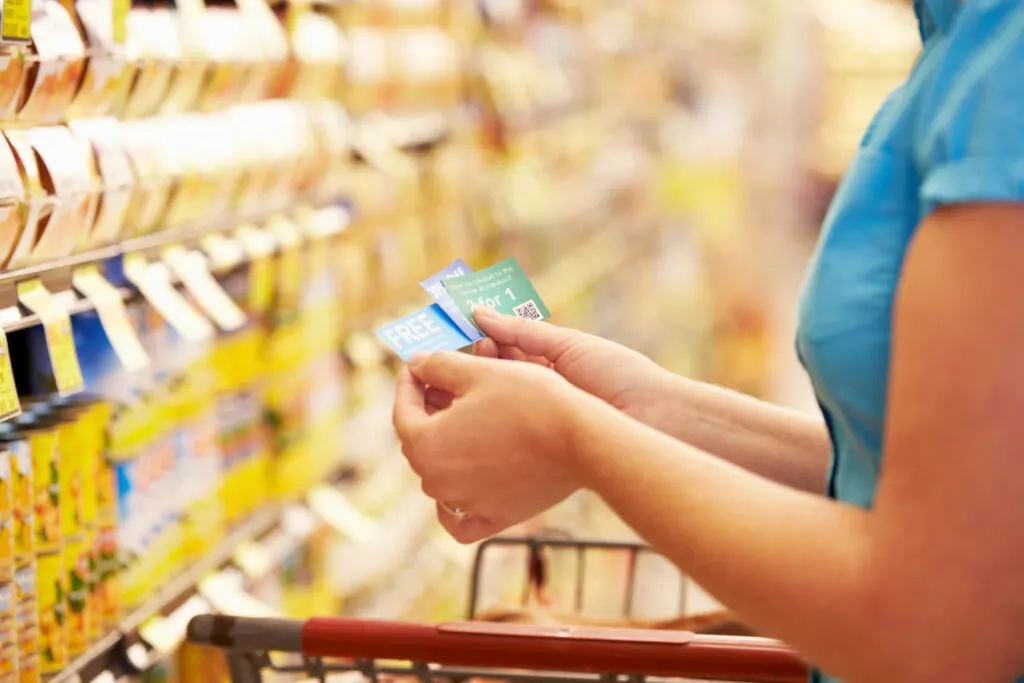Heading to the grocery store can almost send you into shock in the 21st century. As you comb through the aisles, you’ll notice the price of eggs and milk has skyrocketed. Most families have stopped by snacks altogether and are focused on buying ingredients for meals. If you need tips for saving money at the grocery store, then these tips are for you!
This post contains affiliate links.
Tips for Saving Money at the Grocery Store
Keep in mind that there are always new ways to save at the grocery store, you just have to be open to trying these new tips. Grocery stores want you to shop at their store, so it only makes sense to also pay attention to what deals or savings they’re trying to offer you! Pay attention to these tips for saving money when grocery shopping.
1. Shop with a list
Create a grocery list and stick to it when you shop. This will help keep you on track and focused on what you actually need, preventing unnecessary impulse purchases. With technology, you don’t even have to worry about forgetting your list at home. Take a picture of it and email it to yourself.
2. Buy in bulk
Buy larger quantities of staples such as non-perishable foods and household items in bulk from warehouse stores like Costco or Sam’s Club to save big. The big issue with bulk buying is that you can’t just buy anything and everything. You have to know exactly what your family eats and shop in bulk wisely.
3. Compare prices
Compare prices between stores or online to get the best deal for the item you want. While you do have to keep the cost of gas in mind, it is still a great idea to compare prices before you go. Never grocery shop without comparing prices first.
4. Try generic brands
Generic brands are often significantly cheaper than their name-brand counterparts, so don’t be afraid to give them a try! You may be on the fence about trying generic brands. However, keep in mind that most generic brands are packaged by the name brand. You don’t have anything to lose by giving the generic brands a try. Pay attention to the weekly price though because sometimes the generic brand is more expensive than the name brand.
5. Plan meals ahead of time
Planning out meals ahead of time can help reduce food waste and limit your grocery bill since you’ll only buy exactly what you need for the meals you’re making.
6. Take advantage of sales & discounts
Looking out for special offers can help save money on groceries and other essentials, so make sure to check store flyers or websites regularly for any deals available at your local supermarket or grocery store. Always ask your cashier for any sales or discount information you may have missed. Most cashiers know the sales ad like the back of their hand!
I like to stock up on items when they hit a good sale so I have them on hand for later. With meat and vegetables, you can freeze them.
7. Avoid pre-packaged foods and compare prices
Pre-packaged foods can be more expensive than buying ingredients separately, so opt out of this whenever possible to save money in the long term. Truly this can go both ways, so always take the time to look at the prices of making something yourself or buying it pre-packaged.
8. Skip convenience items
Preparing items yourself may take a little more time but it can also save money in the end. This is especially true when it comes to things like lunch meats or fresh produce that tend to have higher markups when pre-sliced or prepped for convenience purposes.
9. Grow your own herbs & veggies
Planting a home garden is an easy way to incorporate fresh fruits and vegetables into your diet without having to worry about high grocery bills every month! You can even plant herbs like basil, thyme, rosemary, so that they’re always available right outside your door whenever needed in cooking dishes or recipes. This tip isn’t for everyone, but it is a great way to save money and fill the gap with expensive groceries.
10. Take advantage of coupons & loyalty programs
Using coupons and loyalty programs offered by supermarkets can often lead to additional savings when shopping for groceries each month! A little trick is to go to the website of the store you want to shop at and “click all” for the coupons. That way you’ll have all the coupons on your savings card already!
Also, check if your local grocery store has bonus points days. For example: King Sooper (Kroger) does 4x fuel rewards points on Fridays and 4x fuel rewards when buying gift cards. You can buy gift cards as gifts, to use on nights out, and to pay for everyday expenses. Then use the fuel points to save on gas at the pump.
11. My favorite money-saving apps are:
Ibotta: Ibotta offers cash back on items you purchase at certain stores. Find offers you like, activate them, and earn cash back.
Fetch: Get 2,000 points when you sign up for Fetch rewards. With fetch you scan in receipts or link your email to the app. Buy items, earn rewards points, and turn the points into gift cards.
Rakuten: When you sign up and make your first purchase of $30 or more you’ll earn $30 bonus. Rakuten offers cash back on online purchases. I use this when shopping online, but also with Sams Club when placing my pick-up orders. Make sure to install the browser plugin because it will automatically remind you to activate cash back!
12. Shop Through Grocery Apps
One of the things that have helped me save the most money while grocery shopping is shopping through my local grocery apps like King Sooper and Walmart. While Walmart doesn’t offer coupons or discounts, other big box grocery stores do, like King Sooper. I plan my meals according to the sales and coupons available in the app that week and place a grocery pick-up order. This saves me time, money, and stops me from buying outside of my list because I am not adding impulse items to the cart while in the store.
What are the three P’s of grocery shopping?
⦁ Planning: Make sure to plan ahead by creating a grocery list, researching recipes, and budgeting for the items you need.
⦁ Purchasing: Ensure that you’re getting the best prices for items by doing price comparisons between stores or online outlets and taking advantage of sales and discounts when available.
⦁ Preserving: Properly store food when you get home from the market to keep it fresh longer and reduce waste.
What is the smartest way to grocery shop?
The smartest way to grocery shop is to plan, compare prices, purchase in bulk, and take advantage of coupons and loyalty programs.
What are the 6 steps to healthy grocery shopping?
- Make a list of the healthy foods and snacks you want to buy.
- Look up nutrition facts online or in-store while shopping to compare products.
- Purchase fresh fruits, vegetables, whole grains, and lean proteins whenever possible.
- Avoid processed foods and unhealthy snacks as much as possible.
- Look for deals on healthy items that may save you money in the long run.
- Try new vegetables and fruits anytime you can. Exposing your body to new foods is a good thing!
Saving money at the grocery store is all about being strategic with your purchases and understanding your own needs and wants. It’s important to create a budget and stick to it, plan meals ahead of time, use coupons strategically, buy in bulk when possible, and consider alternative stores for price comparisons. By making smart choices at the grocery store, you can save big on groceries without sacrificing quality.



